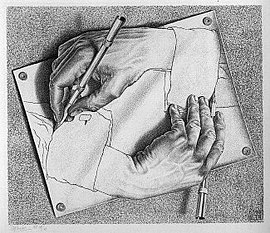|
Drawing Hands
 Drawing Hands is a lithograph by the Dutch artist M. C. Escher first printed in January 1948. It depicts a sheet of paper, out of which two hands rise, in the paradoxical act of drawing one another into existence. This is one of the most obvious examples of Escher's common use of paradox. It is referenced in the book Gödel, Escher, Bach, by Douglas Hofstadter, who calls it an example of a strange loop. It is used in Structure and Interpretation of Computer Programs by Harold Abelson and Gerald Jay Sussman as an allegory for the eval and apply functions of programming language interpreters in computer science, which feed each other. Drawing Hands has been referenced and copied many times by artists in different ways. In tech culture, robot hands draw or build each other,[1] or a human hand and robot hand draw each other.[2][3] References
Bibliography
|
||||||||||||||||||
